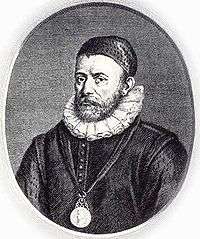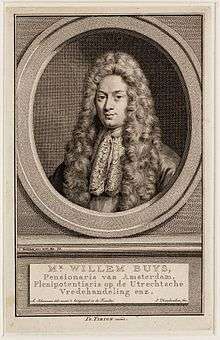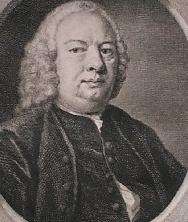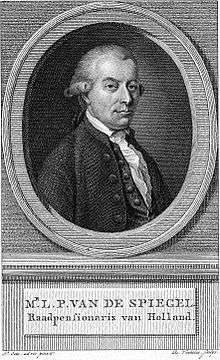Grand pensionary
The grand pensionary (Dutch: raad(s)pensionaris) was the most important Dutch official during the time of the United Provinces. In theory he was only a civil servant of the Estates of the dominant province among the Seven United Provinces: the county of Holland. In practice the grand pensionary of Holland was the political leader of the entire Dutch Republic when there was no stadtholder (in practice the Prince of Orange) at the centre of power.
The Dutch name raad(s)pensionaris literally translates as "councillor or advisor pensionary". Indeed, other provinces could also have a raadspensionaris, e.g. Zeeland, but only the one of Holland was considered by foreign powers to be of any importance, so they called him the grand pensionary.
The position of the grand pensionary was in many ways similar to what through later political and constitutional developments came to be a prime minister.
The office of grand pensionary
The office started in 1619 and replaced the title of land's advocate. When there was a stadtholder, then the grand pensionary was often the second leader of the republic. Being the raadspensionaris of Holland, the grand pensionary acted as the chairman of States of Holland. He was appointed by the Estates and could be fired instantly by the Estates. A decision of the Estates was made by a summarizing of all the statements of the delegates by the grand pensionary, with an implicit conclusion about what collective decision had been made. He had the first say on a subject during a meeting of the Estates and controlled the agenda. This way, if he was a competent man, he could control the entire decision-making process, especially as one of his "duties" was to represent the ten members of the nobility delegates (the ridderschap) in their absence and phrase the single opinion they as a body had the right to express. The office existed because all delegates of the States were, although ranked according to ancient feudal hierarchy, still basically equal (pares) and none among them could thus act as a head.
The Batavian Republic first abolished the office but in its last year, 1805–1806, the title had to be reinstituted on orders of Napoleon as part of a number of measures to strengthen the executive power; Rutger Jan Schimmelpenninck thus acted for a short time as the last grand pensionary. He officially functioned as a president of the entire Republic, not just of Holland.
Grand Pensionaries
The most famous and most significant grand pensionary was Johan de Witt, who held the office between 1653 and 1672. Johan van Oldenbarnevelt, who played an extremely important role in the Dutch struggle for independence should also be mentioned, though he held the position when it was still called "land's advocate".
| Portrait | Name (Birth–Death) |
Term of office | ||
|---|---|---|---|---|
 |
Paulus Buys (1531–1594) |
1572 | 16 March 1584 | |
 |
Johan van Oldenbarnevelt (1547–1619) |
16 March 1586 |
12 May 1619 | |
| Andries de Witt (1573–1637) |
12 May 1619 |
1621 | ||
| Anthonie Duyck (1560–1629) |
1621 | 1629 | ||
 |
Jacob Cats (1577–1660) |
1629 | 1631 | |
.jpg) |
Adriaan Pauw (1585–1653) |
1631 | 1636 | |
 |
Jacob Cats (1577–1660) |
1636 | 1651 | |
.jpg) |
Adriaan Pauw (1585–1653) |
1651 | 30 July 1653 | |
%2C_Grand_Pensionary_of_Holland%2C_by_Studio_of_Adriaen_Hanneman.jpg) |
Johan de Witt (1625–1672) |
30 July 1653 |
4 August 1672 | |
 |
Gaspar Fagel (1634–1688) |
20 August 1672 |
5 December 1688 | |
 |
Michiel ten Hove (1640–1689) |
5 December 1688 |
24 March 1689 | |
| Anthonie Heinsius (1641–1720) |
27 May 1689 |
3 August 1720 | ||
 |
Isaac van Hoornbeek (1655–1727) |
12 September 1720 |
17 June 1727 | |
.jpg) |
Simon van Slingelandt (1664–1736) |
17 July 1727 |
1 December 1736 | |
| Anthonie van der Heim (1693–1746) |
4 April 1737 |
7 July 1746 | ||
 |
Willem Buys (1661–1749) |
7 July 1746 |
23 September 1746 | |
 |
Jacob Gilles (1691–1765) |
23 September 1747 |
18 June 1749 | |
 |
Pieter Steyn (1706–1772) |
18 June 1749 |
5 November 1772 | |
%2C_raadpensionaris_van_Holland_Rijksmuseum_SK-A-4336.jpeg) |
Pieter van Bleiswijk (1724–1790) |
18 June 1772 |
5 November 1787 | |
 |
Laurens Pieter van de Spiegel (1736–1800) |
9 November 1787 |
9 February 1795 | |
Other provinces also had pensionaries. A list of some of them can be found here.
See also
References
- Rowen, H.H. (2003), John de Witt: Statesman of the "True Freedom", Cambridge University Press, ISBN 0521527082
- Brouwer, M. (2008), Governance and Innovation: A Historical View, Routledge, ISBN 0415437059
- Bockel, J. van (2009), Gevormde kaders: bureaucratische en professionele reguliering van het werk van ambtenaren in de Republiek der Zeven Verenigde Nederlanden [Embedded constraints: Bureaucratic and professional regulation of officials' work in the Republic of the Seven United Netherlands] (in Dutch), Eburon Uitgeverij B.V., ISBN 9059723503